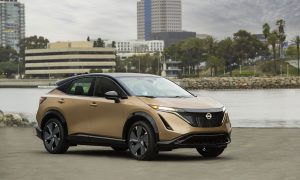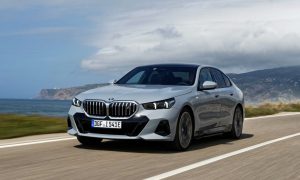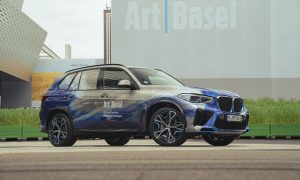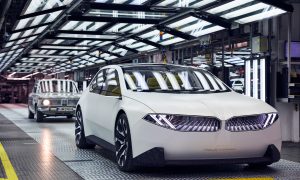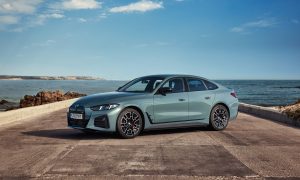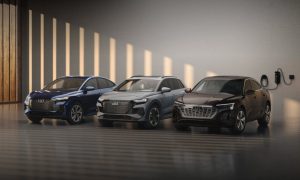News
German auto industry wary of EV innovations inspired by Tesla
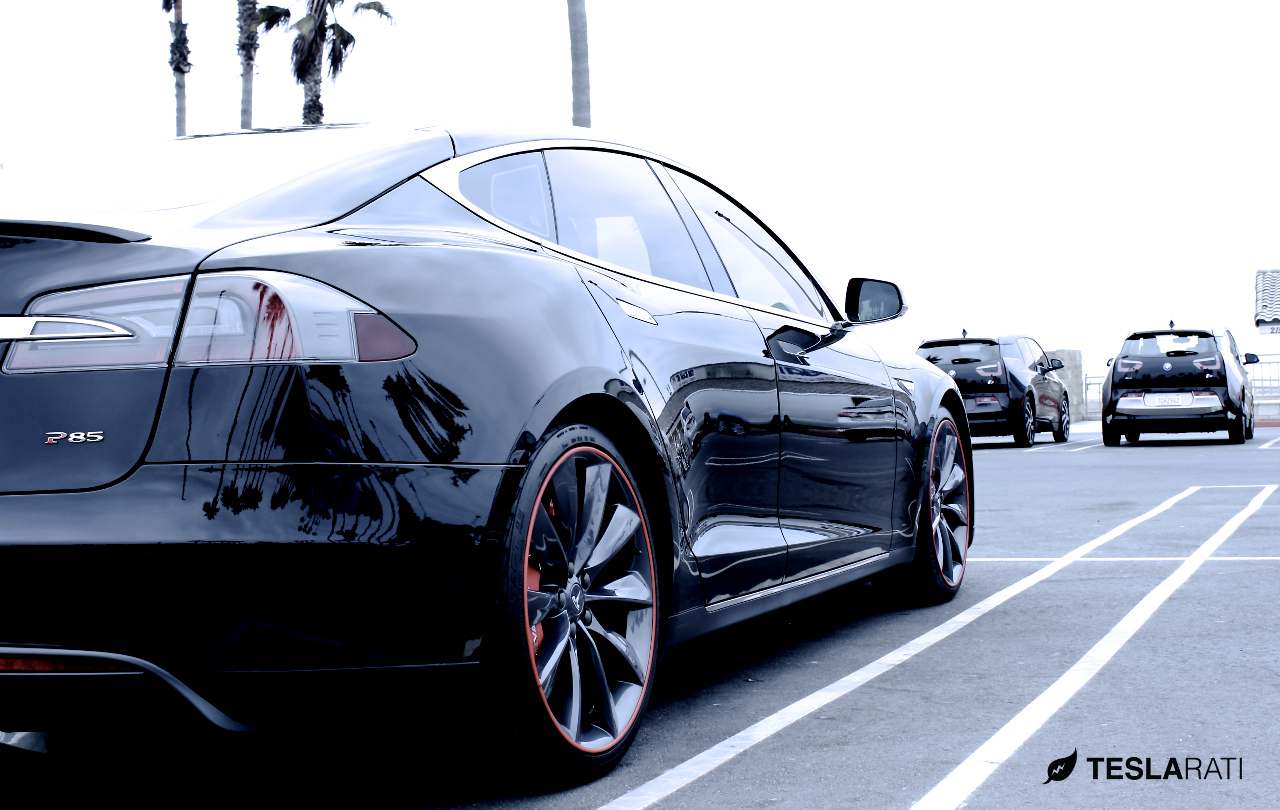
More than 300 high-ranking representatives of the German automotive industry gathered in Berlin recently to hear the President of the German Association of the Automotive Industry (VDA) express firm views that “the calls to ban combustion engines are becoming louder.”
VDA President Matthias Wissmann explained that the German automotive industry has already invested 14 billion euros in electric mobility, and, with 30 electric models in series production, it is currently one of the world’s leading providers of electric mobility. Electric mobility is an important component for achieving climate targets, reducing emissions of pollutants, and lowering CO2. The VDA expects that the country’s automotive manufacturers will more than triple the number of electric vehicle models to nearly 100 by 2020 as battery costs decline and electric ranges increase toward 500 km. That will edge closer to the distances gasoline and diesel cars can travel on a single tank.
Wissman warned that, if energy policy follows developments, both passenger cars and commercial vehicles would need to adhere to increased regulations and automakers would have to engage in some serious self-examination. “This industry is not start-up company that can constantly procure fresh funding despite persistent losses,” he said in a remark likely directed at Tesla. “Today we can imagine that in 2025, 15 to 25 percent of new passenger car registrations worldwide could be electric vehicles. The trend is accelerating – just a short while ago experts thought a share of only 3 percent was more likely. Every fourth or fifth new car sold will then have an electric drive.” Tesla, it must be noted, paid back its Department of Energy loan nine years early.
The German car industry is investing 40 billion euros in alternative drivetrains. This amount includes research and development expenditures as well as assets such as equipment and tools for production. Late last month BMW, Daimler, and the Volkswagen Group were among European automakers that signed a declaration of intent to start next year with the construction of a quick charging network for electric cars based on the CCS standard. Of course, Tesla has also joined the CharIN group, which created and promotes the CCS charging standard commonly found on the SAE-Combo plug.
The German automotive industry has recently intensified research and development activities in the fields of digitization and connected driving. Instead of having “to worry about the new competition,” Wissman said the German automotive industry aims to be right at the forefront of developments. These were more lightly-veiled references to Tesla Motors, Inc., with its Model S now performing as the best selling luxury car in Western Europe, accelerating past traditional high-status and internal combustion engine powered favorites like the Mercedes S class, BMW 7 Series, Audi A8, and Porsche Panamera. Wissman also affirmed that European automakers could not switch immediately to electric vehicles and eliminate combustion engines from their catalogs, as they employ hundreds of thousands of workers around the world – many of which build diesel and gasoline engines.
To accelerate the evolution toward innovative automotive methods, Wissman described how the German automotive industry is now working intensively on new mobility concepts that generate totally new business models. “This trend arises from a rapidly changing expectation on the part of customers, who no longer demand just a product, but instead a mobility service,” Wissmann said. “In addition, completely new players are appearing on the market, such as large IT corporations. We take this challenge seriously, and are also tackling it.”
The VDA recognizes that increased efficiency, recycling, and a reduction in emissions benefit both companies and consumers as is preserving natural resources is an integral part of national and European regulation. They note on their website that, according to figures published in the national Inventory Report of the German Environmental Agency, CO₂ emissions produced by road traffic in Germany from 1999 to 2012 dropped by about 30 million metric tons. “In the last ten years the average fuel consumption by newly registered passenger cars in the EU has been brought down by over one quarter, and CO2 emissions have fallen in parallel,” Wissman noted. “The potential has not yet been exhausted. We expect that in the next few years we can increase the efficiency of gasoline and diesel vehicles by at least another 10 to 15 percent.”
Since 2006, German road traffic CO₂ emissions have been below 1990 levels for the seventh successive year and are around 5 million metric tons less than the 1990 figure. No other Western European country has so far succeeded on a sustained basis in reducing road traffic CO₂ emissions below the level of 1990, according to the VDA. German automakers’ shifts to more fuel-efficient and carbon-reducing vehicles, however, can only help reduce these levels further.
Elon Musk
Tesla Supercharger Diner food menu gets a sneak peek as construction closes out
What are you ordering at the Tesla Diner?

The Tesla Supercharger Diner in Los Angeles is nearing completion as construction appears to be winding down significantly. However, the more minor details, such as what the company will serve at its 50s-style diner for food, are starting to be revealed.
Tesla’s Supercharger Diner is set to open soon, seven years after CEO Elon Musk first drafted the idea in a post on X in 2018. Musk has largely come through on most of what he envisioned for the project: the diner, the massive movie screens, and the intended vibe are all present, thanks to the aerial and ground footage shared on social media.
We already know the Diner will be open 24/7, based on decals placed on the front door of the restaurant that were shared earlier this week. We assume that Tesla Optimus will come into play for these long and uninterrupted hours.
The Tesla Diner is basically finished—here’s what it looks like
As far as the food, Tesla does have an email also printed on the front door of the Diner, but we did not receive any response back (yet) about what cuisine it will be offering. We figured it would be nothing fancy and it would be typical diner staples: burgers, fries, wings, milkshakes, etc.
According to pictures taken by @Tesla_lighting_, which were shared by Not a Tesla App, the food will be just that: quick and affordable meals that diners do well. It’s nothing crazy, just typical staples you’d find at any diner, just with a Tesla twist:
Tesla Diner food:
• Burgers
• Fries
• Chicken Wings
• Hot Dogs
• Hand-spun milkshakes
• And more https://t.co/kzFf20YZQq pic.twitter.com/aRv02TzouY— Sawyer Merritt (@SawyerMerritt) July 17, 2025
As the food menu is finalized, we will be sure to share any details Tesla provides, including a full list of what will be served and its prices.
Additionally, the entire property appears to be nearing its final construction stages, and it seems it may even be nearing completion. The movie screens are already up and showing videos of things like SpaceX launches.
There are many cars already using the Superchargers at the restaurant, and employees inside the facility look to be putting the finishing touches on the interior.
🚨 Boots on the ground at the Tesla Diner:
— TESLARATI (@Teslarati) July 17, 2025
It’s almost reminiscent of a Tesla version of a Buc-ee’s, a southern staple convenience store that offers much more than a traditional gas station. Of course, Tesla’s version is futuristic and more catered to the company’s image, but the idea is the same.
It’s a one-stop shop for anything you’d need to recharge as a Tesla owner. Los Angeles building permits have not yet revealed the date for the restaurant’s initial operation, but Tesla may have its eye on a target date that will likely be announced during next week’s Earnings Call.
News
Tesla’s longer Model Y did not scale back requests for this vehicle type from fans
Tesla fans are happy with the new Model Y, but they’re still vocal about the need for something else.

Tesla launched a slightly longer version of the Model Y all-electric crossover in China, and with it being extremely likely that the vehicle will make its way to other markets, including the United States, fans are still looking for something more.
The new Model Y L in China boasts a slightly larger wheelbase than its original version, giving slightly more interior room with a sixth seat, thanks to a third row.
Tesla exec hints at useful and potentially killer Model Y L feature
Tesla has said throughout the past year that it would focus on developing its affordable, compact models, which were set to begin production in the first half of the year. The company has not indicated whether it met that timeline or not, but many are hoping to see unveilings of those designs potentially during the Q3 earnings call.
However, the modifications to the Model Y, which have not yet been officially announced for any markets outside of China, still don’t seem to be what owners and fans are looking forward to. Instead, they are hoping for something larger.
A few months ago, I reported on the overall consensus within the Tesla community that the company needs a full-size SUV, minivan, or even a cargo van that would be ideal for camping or business use.
Tesla is missing one type of vehicle in its lineup and fans want it fast
That mentality still seems very present amongst fans and owners, who state that a full-size SUV with enough seating for a larger family, more capability in terms of cargo space for camping or business operation, and something to compete with gas cars like the Chevrolet Tahoe, Ford Expedition, or electric ones like the Volkswagen ID.BUZZ.
We asked the question on X, and Tesla fans were nearly unanimously in support of a larger SUV or minivan-type vehicle for the company’s lineup:
🚨 More and more people are *still* saying that, despite this new, longer Model Y, Tesla still needs a true three-row SUV
Do you agree? https://t.co/QmbRDcCE08 pic.twitter.com/p6m5zB4sDZ
— TESLARATI (@Teslarati) July 16, 2025
Here’s what some of the respondents said:
100% agree, we need a larger vehicle.
Our model Y is quickly getting too small for our family of 5 as the kids grow. A slightly longer Y with an extra seat is nice but it’s not enough if you’re looking to take it on road trips/vacations/ kids sports gear etc.
Unfortunately we…
— Anthony Hunter (@_LiarsDice_) July 17, 2025
Had to buy a Kia Carnival Hybrid because Tesla doesn’t have a true 3 row vehicle with proper space and respectable range. pic.twitter.com/pzwFyHU8Gi
— Neil, like the astronaut (@Neileeyo) July 17, 2025
Agreed! I’m not sure who created this but I liked it enough to save it. pic.twitter.com/Sof5nMehjS
— 🦉Wise Words of Wisdom – Inspirational Quotes (IQ) (@WiseWordsIQ) July 16, 2025
Tesla is certainly aware that many of its owners would like the company to develop something larger that competes with the large SUVs on the market.
However, it has not stated that anything like that is in the current plans for future vehicles, as it has made a concerted effort to develop Robotaxi alongside the affordable, compact models that it claims are in development.
It has already unveiled the Robovan, a people-mover that can seat up to 20 passengers in a lounge-like interior.
The Robovan will be completely driverless, so it’s unlikely we will see it before the release of a fully autonomous Full Self-Driving suite from Tesla.
Energy
Tesla launches first Virtual Power Plant in UK – get paid to use solar
Tesla has launched its first-ever Virtual Power Plant program in the United Kingdom.

Tesla has launched its first-ever Virtual Power Plant program in the United Kingdom. This feature enables users of solar panels and energy storage systems to sell their excess energy back to the grid.
Tesla is utilizing Octopus Energy, a British renewable energy company that operates in multiple markets, including the UK, France, Germany, Italy, Spain, Australia, Japan, New Zealand, and the United States, as the provider for the VPP launch in the region.
The company states that those who enroll in the program can earn up to £300 per month.
Tesla has operated several VPP programs worldwide, most notably in California, Texas, Connecticut, and the U.S. territory of Puerto Rico. This is not the first time Tesla has operated a VPP outside the United States, as there are programs in Australia, Japan, and New Zealand.
This is its first in the UK:
Our first VPP in the UK
You can get paid to share your energy – store excess energy in your Powerwall & sell it back to the grid
You’re making £££ and the community is powered by clean energy
Win-win pic.twitter.com/evhMtJpgy1
— Tesla UK (@tesla_uk) July 17, 2025
Tesla is not the only company that is working with Octopus Energy in the UK for the VPP, as it joins SolarEdge, GivEnergy, and Enphase as other companies that utilize the Octopus platform for their project operations.
It has been six years since Tesla launched its first VPP, as it started its first in Australia back in 2019. In 2024, Tesla paid out over $10 million to those participating in the program.
Participating in the VPP program that Tesla offers not only provides enrolled individuals with the opportunity to earn money, but it also contributes to grid stabilization by supporting local energy grids.
-

 Elon Musk1 day ago
Elon Musk1 day agoWaymo responds to Tesla’s Robotaxi expansion in Austin with bold statement
-

 News1 day ago
News1 day agoTesla exec hints at useful and potentially killer Model Y L feature
-

 Elon Musk2 days ago
Elon Musk2 days agoElon Musk reveals SpaceX’s target for Starship’s 10th launch
-

 Elon Musk3 days ago
Elon Musk3 days agoTesla ups Robotaxi fare price to another comical figure with service area expansion
-

 News1 day ago
News1 day agoTesla’s longer Model Y did not scale back requests for this vehicle type from fans
-

 News1 day ago
News1 day ago“Worthy of respect:” Six-seat Model Y L acknowledged by Tesla China’s biggest rivals
-

 News2 days ago
News2 days agoFirst glimpse of Tesla Model Y with six seats and extended wheelbase
-

 Elon Musk2 days ago
Elon Musk2 days agoElon Musk confirms Tesla is already rolling out a new feature for in-car Grok


